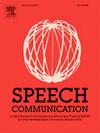Expectation of speech style improves audio-visual perception of English vowels
IF 3
3区 计算机科学
Q2 ACOUSTICS
引用次数: 0
Abstract
Speech perception is influenced by both signal-internal properties and signal-independent knowledge, including communicative expectations. This study investigates how these two factors interact, focusing on the role of speech style expectations. Specifically, we examine how prior knowledge about speech style (clear versus plain speech) affects word identification and speech style judgment. Native English perceivers were presented with English words containing tense versus lax vowels in either clear or plain speech, with trial conditions manipulating whether style prompts (presented immediately prior to the target word) were congruent or incongruent with the actual speech style. The stimuli were also presented in three input modalities: auditory (speaker voice), visual (speaker face), and audio-visual. Results show that prior knowledge of speech style improved accuracy in identifying style after the session when style information in the prompt and target word was consistent, particularly in auditory and audio-visual modalities. Additionally, as expected, clear speech enhanced word intelligibility compared to plain speech, with benefits more evident for tense vowels and in auditory and audio-visual contexts. These results demonstrate that congruent style prompts improve style identification accuracy by aligning with high-level expectations, while clear speech enhances word identification accuracy due to signal-internal modifications. Overall, the current findings suggest an interplay of processing sources of information which are both signal-driven and signal-independent, and that high-level signal-complementary information such as speech style is not separate from, but is embodied in, the signal.
语音风格的预期提高了英语元音的视听感知
语音感知受信号内部属性和信号独立知识(包括交际期望)的影响。本研究探讨了这两个因素是如何相互作用的,重点是演讲风格期望的作用。具体来说,我们研究了关于语言风格的先验知识(清晰的语言与平淡的语言)如何影响单词识别和语言风格判断。母语为英语的感知者以清晰或平淡的语言呈现含有时态和松散元音的英语单词,并在试验条件下操纵风格提示(在目标单词之前立即呈现)是否与实际语言风格一致或不一致。刺激也以三种输入方式呈现:听觉(说话人的声音)、视觉(说话人的脸)和视听。结果表明,当提示词和目标词的风格信息一致时,对语言风格的先验知识提高了会话后识别风格的准确性,尤其是在听觉和视听模式下。此外,正如预期的那样,清晰的语言比平淡的语言更能提高单词的可理解性,对于时态元音以及听觉和视听环境的好处更为明显。这些结果表明,一致的风格提示通过与高水平期望保持一致来提高风格识别的准确性,而清晰的语音提示由于信号内部修改而提高单词识别的准确性。总的来说,目前的研究结果表明,信号驱动和信号独立的信息处理源之间存在相互作用,并且语音风格等高级信号互补信息不是与信号分离,而是体现在信号中。
本文章由计算机程序翻译,如有差异,请以英文原文为准。
求助全文
约1分钟内获得全文
求助全文
来源期刊

Speech Communication
工程技术-计算机:跨学科应用
CiteScore
6.80
自引率
6.20%
发文量
94
审稿时长
19.2 weeks
期刊介绍:
Speech Communication is an interdisciplinary journal whose primary objective is to fulfil the need for the rapid dissemination and thorough discussion of basic and applied research results.
The journal''s primary objectives are:
• to present a forum for the advancement of human and human-machine speech communication science;
• to stimulate cross-fertilization between different fields of this domain;
• to contribute towards the rapid and wide diffusion of scientifically sound contributions in this domain.
 求助内容:
求助内容: 应助结果提醒方式:
应助结果提醒方式:


